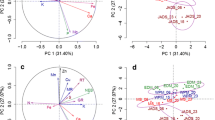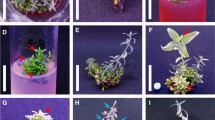Abstract
Applications of in vitro screening techniques for Pinus ponderosa resistance to Peridermium harknessii could be beneficial in a tree breeding program. Plant growth regulators, basal media formula and carbohydrate levels were examined to determine the various effects each would have on excised cotyledon growth and development. Proliferating green callus was initiated from cotyledon explants on SH basal medium containing 4.4 μM BA:5.4 μM NAA and 1% sucrose. Subsequent subculturing onto LS medium supplemented with 44.0 μM BA: 5.4 μM NAA and 2% sucrose improved callus maintenance. The highest frequency of caulogenesis from cotyledon explants occurred on a modified GD medium containing 44.0 μM BA: 0.054 μM NAA and 4% glucose. The influence of nitrogen source, osmoticum and medium salt concentrations are discussed relative to callus initiation and caulogenesis.
Similar content being viewed by others
Abbreviations
- BA:
-
6-benzyladenine
- NAA:
-
α-naphthaleneacetic acid
- IAA:
-
indole-3-acetic acid
- IBA:
-
indole-3-butyric acid
- 2,4-D:
-
2,4-dichlorophenoxyacetic acid
- CD:
-
Campbell & Durzan
- GD:
-
Gresshoff & Doy
- LP:
-
Le Poivre
- LS:
-
Linsmaier & Skoog
- MC:
-
McCown
- SH:
-
Schenk & Hildebrandt
References
Aitken-Christie J (1984) Micropropagation of Pinus radiata. The Plant Prop 30: 9–11
Barlass M, Miller RM, Antcliff AJ (1986) Development of methods for screening grapevines for resistance to infection for Downy Mildew. I. Dual culture in vitro. Am J Enol Vitic 37: 61–66
Bermudez P, Sommer HE (1987) Factors affecting adventitious bud induction in Pinus elliottii (Engelm.) embryos cultured in vitro. Plant Cell Tissue Organ Culture 11: 25–35
Bonga JM (1982) Tissue culture techniques. In: Bonga JM, Durzan DJ (Eds) Tissue Culture in Forestry (pp 4–36) Martinus Nijhoff/Dr W Junk Publishers, Dordrecht
Boulay MP, Gupta PK, Krogstrup P, Durzan DJ (1988) Development of somatic embryos from suspension cultures of Norway spruce (Picea abies Karst.). Plant Cell Rep 7: 134–137
Brown DC, Leung DW, Thorpe TA (1979) Osmotic requirements for shoot formation in tobacco callus. Physiol Plant 46: 36–41
Campbell RA, Durzan DJ (1975) Induction of multiple buds and needles in tissue cultures of Picea glauca. Can J Bot 53: 1652–1657
Chalupa V, Durzan DJ, Vithaysai C (1976) Growth and metabolism of cells and tissues of jack pine (Pine bankisana). 2. Quantitative analysis of growth of callus from hypocotyls and radicles. Can J Bot 54: 446–455
Cheng TY (1975) Adventitious bud formation in culture of Douglas fir (Pseudotsuga menziesii (Mirb) Franco). Plant Sci Lett 5: 97–102
Durzan DJ (1982) Nitrogen metabolism and vegetative propagation of forest trees. In: Bonga JM, Durzan DJ (Eds) Tissue Culture in Forestry (pp 256–325) Martinus Nijhoff/Dr W Junk Publishers, Dordrecht
Durzan DJ, Gupta PK (1987) Somatic embryogenesis and polyembryogenesis in Douglas fir cell suspension cultures. Plant Sci 52: 229–235
Ellis DD, Bilderback DE (1984) Multiple bud formation by cultured embryos of Pinus ponderosa. J Plant Physiol 115: 201–204
Ellis DD, Bilderback DE (1989) Temporal competence of embryonic Pinus ponderosa cotyledons to form multiple buds in vitro. Am J Bot 76 (in press)
Flinn BS, Webb DT, Georgis W (1986) In vitro control of caulogenesis by growth regulators and media components in embryonic explants of eastern white pine (Pinus strobus). Can J Bot 64: 1948–1956
Gamborg OL, Shyluk JP (1970) The culture of plant cells with ammonium salts as the sole nitrogen source. Plant Physiol 45: 598–600
Gresshoff PM, Doy CH (1972) Development and differentiation of haploid Lycopersicon esculentum. Planta 107: 161–170
Haberlach GT, Budde AD, Sequeria L, Helgeson JP (1978) Modification of disease resistance of tobacco callus tissues by cytokinins. Plant Physiol 62: 522–525
Harvey AE, Grasham JL (1969) Procedures and media for obtaining tissue culture of 12 conifer species. Can J Bot 47: 547–549
Helgeson JP, Kemp JD, Haberlach GT, Maxwell DP (1972) A tissue culture system for studying disease resistance: the black shank disease in tobacco callus cultures. Phytopathology 62: 1439–1443
Holliday MJ, Klarman WL (1979) Expression of disease reaction types in soybean callus from resistant and susceptible plants. Phytopathology 69: 576–578
Hrib J, Rypacek V (1983) In vitro testing for the resistance of conifers to the fungus Phaeolus schweinitzii (Fr.) Pat. on callus cultures. Eur J For Pathol 13: 86–91
Joung H, Korban SS, Skirvin RM (1987) Screening shoot cultures of Malus for cedar-apple rust infection by in vitro inoculation. Plant Dis 71: 1119–1122
Konar RN, Singh MH (1980) Induction of shoot buds from tissue cultures of Pinus wallichiana. Z Pflanzenphysiol 99: 173–177
Linsmaier EM, Skoog F (1965) Organic growth factor requirements of tobacco tissue cultures. Physiol Plant 18: 100–127
Lloyd G, McCown B (1980) Commercially feasible micropropagation of mountain laurel (Kalmia latiflora) by use of shoot tip culture. Proc Int Plant Prop Soc 30: 421–427
Patel KR, Thorpe TA (1984) In vitro differentiation of plantlets from embryonic explants of lodgepole pine (Pinus contorta Doug. ex Loud.). Plant Cell Tissue Organ Culture 3: 131–142
Sommer HE, Brown CL, Kormanik P (1975) Differentiation of plantlets in longleaf pine (Pinus palustris Mill.) tissue cultured in vitro. Bot Gaz 136: 196–200
SAS Institute Inc (1985) SAS User's Guide. Version 5.
Schenk RU, Hildebrandt AC (1972) Medium and techniques for induction and growth of monocotyledonous and dicotyledonous plant cell cultures. Can J Bot 50: 199–204
Steel RG, Torrie JH (1980) Principles and procedures of statistics. McGraw-Hill Inc
Thorpe TA (1982) Carbohydrate utilization and metabolism. In: Bonga JM, Durzan DJ (Eds) Tissue Culture in Forestry (pp 325–368) Martinus Nijhoff/Dr W Junk, Publishers, Dordrecht
Walla JA, Tuskan GA (1987) Studies of western gall rust resistance in ponderosa pine. Proc 5th North Central Tree Improvement Conf, Fargo, ND, 10–12 Aug 1987 (pp 101–112)
Author information
Authors and Affiliations
Rights and permissions
About this article
Cite this article
Tuskan, G.A., Sargent, W.A., Rensema, T. et al. Influence of plant growth regulators, basal media and carbohydrate levels on the in vitro development of Pinus ponderosa (Dougl. ex Law.) cotyledon explants. Plant Cell Tiss Organ Cult 20, 47–52 (1990). https://doi.org/10.1007/BF00034756
Received:
Accepted:
Issue Date:
DOI: https://doi.org/10.1007/BF00034756




